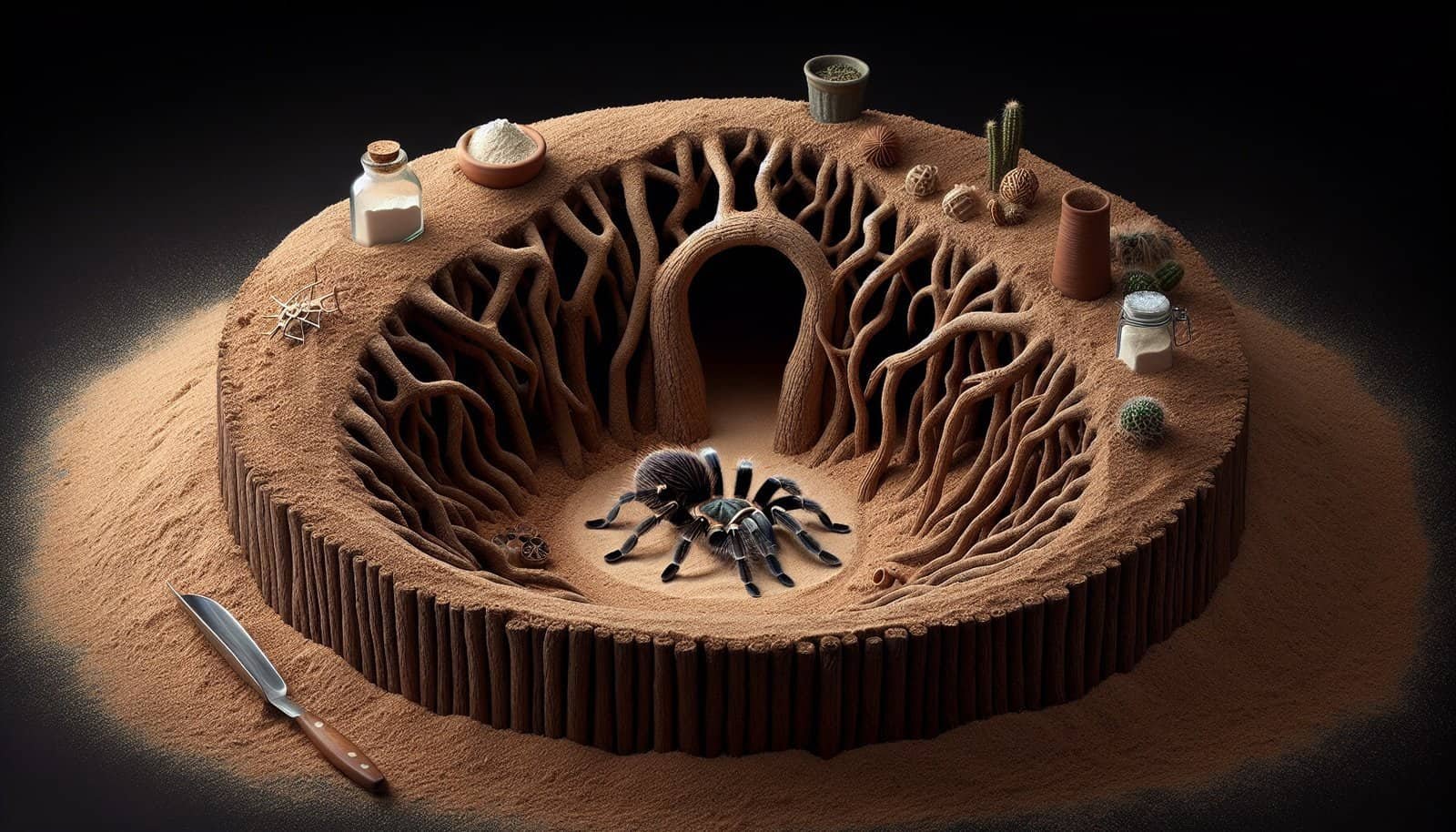So you’ve decided to delve into the world of tarantula ownership and have your eye on a burrowing species? That’s fantastic! Setting up a proper enclosure for burrowing tarantulas requires a bit of knowledge and careful consideration, but fear not, because we’re here to guide you through the process step by step. From selecting the right substrate and providing sufficient hiding spots to ensuring proper ventilation and humidity levels, we’ll cover all the essential elements to create a comfortable and safe home for your new eight-legged friend. Get ready to create the perfect habitat for your burrowing tarantula!

Choosing the Right Enclosure
Size of the Enclosure
When choosing an enclosure for your burrowing tarantula species, it is important to consider the size of the enclosure. Tarantulas require enough space to move around comfortably and create their burrows. A general rule of thumb is to provide a tank that is at least three times the leg span of your tarantula in width and depth. This gives them ample room to explore and burrow to their heart’s content.
Material of the Enclosure
The material of the enclosure is also an important factor to consider when setting up a tarantula habitat. Glass or acrylic enclosures are the most common choices, as they provide a clear view of your tarantula and are generally easy to clean. Ensure that the material is sturdy and secure to prevent any escapes. Additionally, make sure the enclosure has proper ventilation to maintain a healthy environment for your tarantula.
Lid or Top of the Enclosure
When selecting an enclosure for your burrowing tarantula, it is essential to choose one with a secure and well-fitting lid or top. Tarantulas are adept climbers and can easily escape if the lid is not tightly secured. Look for enclosures with locking mechanisms or additional measures like clips or rubber bands to ensure your tarantula remains safely inside.
Substrate Selection
Natural Substrate Options
Choosing the right substrate is crucial for creating a suitable burrowing environment for your tarantula. Many tarantula keepers opt for natural substrates, such as a mixture of peat moss, coconut fiber, and topsoil. This combination creates a loose and moist substrate that mimics the tarantula’s natural habitat. It allows for easy burrowing and maintains the necessary humidity levels.
Artificial Substrate Options
If natural substrates are not readily available or not your preferred choice, there are also artificial substrate options, such as reptile-safe carpet or paper towels. These options are easy to clean and maintain, but they may not provide the same level of burrowing satisfaction for your tarantula. It is important to ensure that any artificial substrate used is non-toxic and safe for your tarantula.
Creating a Burrow
Providing Hiding Places
Tarantulas are secretive creatures that appreciate hiding places within their enclosure. You can provide them with various hiding spots by adding artificial or natural decorations like cork bark, hollow logs, or fake plants. These hiding places offer your tarantula a sense of security and encourage natural behaviors like burrowing.
Adding Burrowing Depth
To truly accommodate your burrowing tarantula’s needs, it is crucial to provide enough depth for them to dig their burrow. The substrate depth should be at least twice the leg span of your tarantula. This allows them to create extensive tunnels and chambers, mimicking their natural burrows in the wild. Be sure to pack the substrate loosely to prevent collapses and injuries.
Maintaining Humidity
Burrowing tarantula species often originate from humid environments, so it is essential to maintain the proper humidity levels within their enclosure. Mist the enclosure with water regularly to ensure the substrate remains moist, but be cautious not to oversaturate it, as excessive moisture can lead to mold and other issues. Using a hygrometer can help you monitor the humidity levels and make necessary adjustments.
Temperature and Lighting
Ideal Temperature Range
Tarantulas are ectothermic creatures, meaning they rely on their environment to regulate their body temperature. The ideal temperature range for most tarantula species is between 75 to 85 degrees Fahrenheit (24 to 29 degrees Celsius). It is important to provide a temperature gradient within the enclosure, allowing your tarantula to choose the area that best suits its needs.
Appropriate Lighting
While tarantulas do not require specialized lighting like reptiles, providing a gentle light source can help maintain a consistent day-night cycle. Avoid using bright, direct lighting, as it may cause stress to your tarantula. Indirect ambient light or a low-wattage bulb can provide enough lighting for you to observe your tarantula without negatively impacting its well-being.

Water Source
Water Dish Placement
Providing a water source is crucial for maintaining your tarantula’s hydration. Place a shallow water dish in the enclosure, ensuring it is easily accessible for your tarantula. Avoid placing it directly under a heat source or in areas prone to spillage. It’s important to clean and refill the water dish regularly to ensure it remains fresh and free of contaminants.
Misting the Enclosure
In addition to a water dish, misting the enclosure can help maintain the necessary humidity levels for your burrowing tarantula. Use a fine mist spray bottle to lightly mist the substrate, providing moisture for your tarantula to drink and ensuring the substrate remains adequately humid. Be cautious not to oversaturate the enclosure, as it can lead to excess moisture and potential health issues.
Avoiding Contaminants
Chemical-free Substrate
When selecting substrate options, opt for chemical-free varieties to ensure the safety of your tarantula. Avoid substrates that may contain pesticides, fertilizers, or other harmful chemicals. These substances can be detrimental to your tarantula’s health and well-being. Always read labels and opt for substrates specifically designed for use with reptiles or invertebrates.
Non-toxic Decorations
When adding decorations to your tarantula’s enclosure, it is crucial to choose non-toxic options. Avoid using decorations treated with dyes, paints, or other potentially harmful substances. Natural decorations like cork bark or coconut hides are often safe choices. Remember to thoroughly clean and inspect any new decorations before adding them to the enclosure to ensure they are free from contaminants.

Cleaning and Maintenance
Spot Cleaning
Regular spot cleaning is essential to maintain a clean and healthy environment for your tarantula. Remove any uneaten prey items, shed exoskeletons, or feces promptly to prevent bacterial growth and odor. Additionally, monitor the enclosure for any signs of mold or mites, addressing these issues promptly to prevent potential health problems.
Regular Substrate Changes
Despite spot cleaning, regular substrate changes are still necessary to maintain a clean and hygienic enclosure for your tarantula. The frequency of substrate changes depends on the size of your tarantula and the overall cleanliness of the enclosure. As a general guideline, aim to replace the substrate every three to six months. During substrate changes, thoroughly clean the enclosure to remove any residual waste or contaminants.
Cleaning Decorations
When cleaning the enclosure, do not forget to clean the decorations as well. Remove any dirt, debris, or waste from the hiding places and decorations regularly. Depending on the material, you can wash them with warm water and mild soap or sanitize them with reptile-safe disinfectants. Ensure that all decorations are thoroughly dried before placing them back into the enclosure to prevent mold or bacterial growth.
Feeding and Handling
Feeding Frequency and Diet
The feeding frequency and diet vary depending on the tarantula species and its size. As a general guideline, most tarantulas require one or two appropriately sized prey items per week. Feeder insects like crickets, roaches, or mealworms are commonly used. It is essential to provide a varied diet to ensure your tarantula receives the necessary nutrients. Avoid feeding your tarantula wild-caught insects, as they may carry parasites or toxins.
Proper Handling Techniques
While some tarantula species can be handled, it is important to approach handling with caution and only when necessary. Always ensure your hands are clean and free of any chemicals or lotions before handling your tarantula. Gently coax your tarantula into a container or use a soft brush to encourage it to move if needed. Avoid handling during molting or when your tarantula is displaying signs of stress.

Potential Health Issues
Signs of Illness
Monitoring your tarantula’s health is crucial to catch any signs of illness early. Signs of illness in tarantulas can include changes in appetite, lethargy, abnormal posture, excessive webbing, discoloration, or visible injuries. If you notice any of these signs, it is important to consult a qualified veterinarian who specializes in arachnids for an accurate diagnosis and appropriate treatment.
Common Health Problems
Some common health problems in tarantulas include dehydration, mite infestations, respiratory issues, and molting difficulties. Ensuring proper hydration, cleanliness, and suitable environmental conditions can help prevent many health problems. Regular observation and prompt action are vital to maintaining your tarantula’s health and well-being.
Monitoring and Observation
Observation Techniques
Observing your tarantula’s behavior is a fascinating way to understand and care for it better. Take the time to observe your tarantula during feeding, burrowing, or general activity. Record their behaviors, such as hunting techniques, web spinning, or burrowing patterns, to gain insights into their overall health and well-being.
Recording Behavior Changes
Keeping a record of your tarantula’s behavior changes can be beneficial for identifying any potential health issues or changes in their environment. Note any variations in eating habits, activity levels, or alterations in hiding behaviors. Monitoring these changes over time can help you identify patterns and address any concerns promptly.
Setting up a suitable enclosure for your burrowing tarantula species is both an art and a science. By considering the size, materials, and design of the enclosure, selecting the right substrate, providing hiding places and burrowing depth, maintaining suitable temperature and lighting, offering a water source, avoiding contaminants, cleaning and maintaining the enclosure, and ensuring proper feeding and handling, you can create a safe and enriching environment for your tarantula. Regular observation, monitoring, and addressing potential health issues promptly will help ensure your tarantula thrives in its burrowing enclosure.

